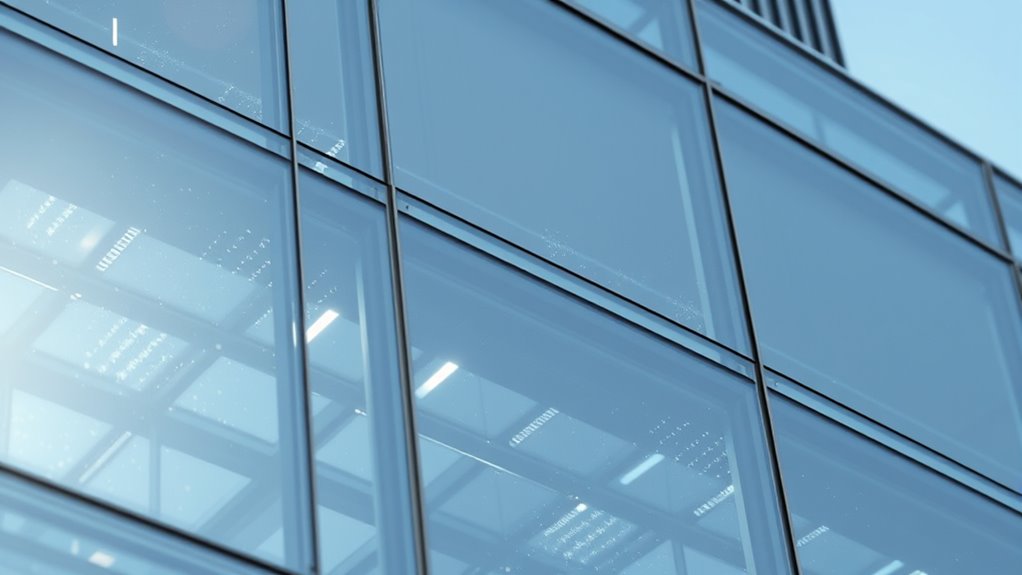Solar windows turn your building’s transparent surfaces into powerful energy sources by integrating innovative photovoltaic materials that capture sunlight without sacrificing clarity or aesthetics. These advanced systems use nanomaterials, spectral filtering, and nanostructures to boost efficiency and durability, making them ideal for urban environments. As technology improves, more cities are adopting solar windows to cut energy costs and promote sustainability. If you want to explore how they’re shaping future urban spaces, keep exploring.
Key Takeaways
- Solar windows integrate photovoltaic materials into transparent glass, converting sunlight into electricity while maintaining aesthetic appeal.
- Advances in nanomaterials and spectral filtering enhance efficiency, durability, and seamless architectural integration.
- Urban buildings utilizing solar windows can generate clean energy, reduce grid reliance, and meet sustainability goals.
- Aesthetic and design challenges are being addressed through innovative coatings and vintage-inspired aesthetics for wider acceptance.
- Policy incentives and scalable implementations are accelerating adoption, transforming city skylines into self-sufficient, sustainable environments.
How Solar Windows Work and Their Core Technologies

Solar windows work by integrating photovoltaic materials directly into the glass, allowing them to generate electricity while still serving as transparent windows. The core technology relies on optimizing quantum efficiency, which measures how effectively the solar cells convert light into electrical energy. High quantum efficiency guarantees maximum energy capture from available sunlight. Spectral filtering plays a vital role by selectively absorbing specific wavelengths of sunlight, enhancing overall efficiency. This process minimizes wasted energy and improves the power output of the solar window. These technologies work together to balance transparency with energy production, allowing the window to function as both a source of clean energy and a clear, natural light source. Additionally, advances in Spectral filtering and materials science are continuously improving the durability and performance of solar windows. As a result, solar windows can contribute considerably to sustainable building design and energy independence.
Advantages of Integrating Solar Windows Into Buildings

Integrating solar windows into buildings offers several compelling advantages, primarily by transforming the glass surfaces into productive energy sources. This approach maximizes space efficiency without compromising aesthetics or natural lighting. Solar windows can contribute directly to a building’s energy needs, reducing reliance on external power sources. When combined with effective energy storage solutions, they enable you to store excess energy for later use, enhancing independence from the grid. Additionally, favorable regulatory policies are increasingly supporting solar innovations, making it easier to install and benefit from solar windows. These policies can lower upfront costs and streamline approvals, accelerating adoption. The rise of solar delivery trends emphasizes the increasing importance of integrating sustainable energy solutions like solar windows in modern infrastructure. Overall, integrating solar windows helps you save on energy costs, supports sustainable practices, and aligns with evolving regulations promoting clean energy solutions.
Material Innovations Driving Solar Window Development

Advances in photovoltaic materials are transforming how solar windows generate energy while remaining transparent. Innovative transparent solar cell technologies enable windows to produce power without blocking light or views. These material breakthroughs are key to making solar windows more efficient and widely applicable. Incorporating n nutrient-rich ingredients into the design of solar window coatings can further enhance energy absorption and overall performance.
Advanced Photovoltaic Materials
Have you ever wondered how new materials are transforming the way we harness sunlight through windows? Advanced photovoltaic materials are at the forefront, utilizing nanomaterial innovations to improve efficiency and flexibility. These innovations enable solar windows to be more lightweight, adaptable, and effective in capturing sunlight. Key features include:
- Enhanced light absorption through nanostructures
- Increased coating durability for long-lasting performance
- Improved integration with building designs
These developments mean solar windows can withstand environmental stresses while maintaining high energy conversion rates. By leveraging nanomaterials, manufacturers are creating coatings that are more resilient, ensuring longevity and consistent output. For example, nanomaterial innovations are allowing for more efficient light management and energy conversion. As a result, solar windows become a practical and attractive option for generating clean energy within urban environments, pushing the boundaries of traditional photovoltaic technology.
Transparent Solar Cell Technologies
Building on the progress in photovoltaic materials, innovations in transparent solar cells are now revolutionizing solar window technology. Quantum dots play a key role by enabling efficient light absorption while remaining transparent, making windows functional as energy generators without sacrificing aesthetics. These tiny semiconductor particles can be tuned to absorb specific wavelengths, allowing for effective color filtering that ensures the glass retains its clarity and visual appeal. This technology allows solar windows to blend seamlessly into buildings, converting sunlight into electricity without obstructing views or natural light. As research advances, transparent solar cells using quantum dots and color filtering techniques become more efficient, paving the way for widespread adoption. Quantum dot technology is rapidly evolving, promising even greater efficiency and versatility in future applications. You can now imagine a future where every window contributes to clean energy production, all while maintaining architectural beauty.
Challenges and Limitations Facing Solar Window Adoption

You might find that high costs and lower efficiency still limit the widespread use of solar windows. Additionally, some designs struggle to blend seamlessly with building aesthetics, making integration tricky. These challenges need addressing before solar windows can become a common feature. Improving energy efficiency is essential for broader adoption and performance.
Cost and Efficiency Challenges
Although solar windows hold promise for transforming energy generation in urban environments, their widespread adoption faces significant hurdles related to cost and efficiency. Pricing hurdles make these advanced materials expensive, limiting affordability for mass deployment. Additionally, production scalability remains a challenge, as manufacturers struggle to produce large quantities without compromising quality. To overcome these issues, you need to contemplate:
- Improving manufacturing processes to increase output efficiently
- Reducing material costs through innovative techniques
- Enhancing solar cell efficiency to maximize energy output
- Developing scalable manufacturing methods that can meet increasing demand without raising costs
Without addressing these factors, solar windows may remain a niche technology rather than a mainstream solution. Overcoming cost and efficiency barriers is vital for making solar windows a viable, sustainable energy option for cities worldwide.
Aesthetic and Integration Concerns
While advancements in manufacturing and cost reduction are essential, integrating solar windows into urban architecture presents aesthetic and design challenges. You might worry about maintaining the building’s visual appeal, as solar windows can alter the aesthetic integration with existing structures. Achieving design harmony is critical; solar windows need to blend seamlessly without compromising style or function. Some designs risk appearing bulky or unattractive, which could deter architects and developers. To overcome this, manufacturers focus on creating transparent, sleek panels that mimic traditional windows. However, striking the right balance between energy efficiency and visual appeal remains a challenge. Incorporating vintage decor elements into solar window designs could help enhance their aesthetic appeal and facilitate better integration. Ultimately, addressing these aesthetic and integration concerns is indispensable for wider adoption, ensuring solar windows enhance, rather than detract from, architectural beauty and urban landscapes.
Current Examples and Successful Implementations

Several innovative projects demonstrate how solar windows are already making an impact. For example, buildings in urban centers incorporate these windows to meet stricter building codes and sustainability goals. In some cities, skyscrapers feature solar glass that generates power while maintaining clear views, seamlessly blending into urban planning strategies. These implementations showcase the practicality of integrating solar windows into existing infrastructure. Additionally, advancements in energy efficiency are making solar window technology increasingly viable for widespread adoption.
Key points include:
- Compliance with evolving building codes encourages adoption.
- Urban planning now favors energy-efficient, solar-integrated designs.
- Successful projects demonstrate scalability and real-world benefits.
As a result, solar windows are becoming a practical energy source, transforming city skylines and contributing to cleaner, more sustainable urban environments.
Future Trends and Potential Impact on Urban Environments

As solar window technology continues to advance and prove its practicality, its influence on urban environments is set to grow considerably. Future trends suggest that cities will integrate solar windows into building designs more systematically, shaping urban planning to prioritize energy-efficient, aesthetically pleasing structures. This shift could lead to smarter zoning policies that encourage or mandate solar window installations, promoting sustainable development. Policy implications may include incentives for early adopters and regulations that streamline approval processes. As a result, urban skylines will become more self-sufficient, reducing reliance on traditional power grids. You’ll likely see a transformation where energy generation seamlessly blends into cityscapes, fostering cleaner environments and inspiring innovative architectural standards for future urban growth.
How to Incorporate Solar Windows Into Your Sustainable Plans

Integrating solar windows into your sustainable plans begins with evaluating your building’s design and energy needs. Assess how much sunlight your space receives and determine your energy goals. To maximize benefits, consider:
Start your sustainable journey by evaluating your building’s sunlight and energy goals for effective solar window integration.
- Investing in energy storage solutions to store excess solar power for later use
- Exploring government incentives that reduce installation costs and encourage sustainable upgrades
- Choosing high-efficiency solar windows compatible with your building’s architecture
- Considering the antioxidant properties of materials used in solar window coatings to improve long-term durability and performance
Frequently Asked Questions
What Is the Average Lifespan of Solar Windows?
You might wonder about the average lifespan of solar windows. Generally, solar window durability depends on various lifespan factors like material quality, installation, and weather conditions. Most solar windows last around 20 to 25 years, similar to traditional solar panels, but proper maintenance can extend their lifespan. Keep in mind that investing in high-quality materials and regular upkeep helps guarantee you get the most out of your solar window’s durability over time.
How Do Solar Windows Affect Building Aesthetics?
You’ll find that solar windows enhance building aesthetics through architectural integration, blending seamlessly with existing designs. They offer design flexibility, allowing you to customize transparency and style to match your vision. While they add a modern, sleek look, they also maintain functionality, ensuring energy efficiency without sacrificing visual appeal. This combination makes solar windows an innovative choice for aesthetically pleasing, sustainable buildings that stand out.
Are Solar Windows Cost-Effective for Homeowners?
You might wonder if solar windows are cost-effective for homeowners. While the installation costs can be higher upfront, they offer significant cost savings over time through reduced energy bills. Plus, they replace traditional windows, saving on replacement costs. If you’re looking for a sustainable option that pays off in the long run, solar windows could be a smart investment, balancing initial expenses with ongoing energy savings.
Do Solar Windows Require Special Maintenance or Cleaning?
You might wonder if solar windows need special maintenance or cleaning. Generally, you should follow simple maintenance tips, like regularly checking for dirt or debris that could block sunlight. Cleaning frequency depends on your environment—more often in dusty or polluted areas. Use gentle cleaning methods, such as a soft cloth and mild soap, to keep your solar windows efficient. Routine upkeep guarantees maximum energy generation without requiring complex maintenance.
How Do Solar Windows Perform in Low-Light or Cloudy Conditions?
Imagine the sun’s rays playing hide and seek—you might wonder how solar windows perform in low-light or cloudy conditions. They still work because their solar transmittance allows some light to pass through, while they maximize light absorption even in dim conditions. This balance guarantees you get energy generation without sacrificing visibility. So, even on cloudy days, your solar windows continue to harness solar power, proving their resilience and efficiency.
Conclusion
Embracing solar windows can transform your building into a clean energy powerhouse. Imagine upgrading a downtown office tower, like the Edge in Amsterdam, where sleek glass panels generate electricity while maintaining stunning views. By integrating this innovative technology, you not only reduce your carbon footprint but also boost energy efficiency. As solar window advancements continue, you’ll lead the way in sustainable urban living—turning everyday structures into essential parts of our clean energy future.










